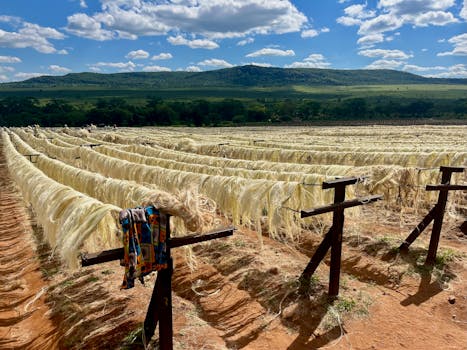Natural Fibers, Global Markets: Africa’s Role in the Sustainable Textile Revolution

Natural Fibers, Global Markets: Africa’s Role in the Sustainable Textile Revolution
Natural Fibers, Global Markets: Africa’s Role in the Sustainable Textile Revolution. The world is shifting towards sustainability, and the textile industry is no exception. With the growing awareness of environmental issues and the need for eco-friendly products, natural fibers have become increasingly popular. Africa, with its rich resources and growing textile industry, is playing a significant role in the sustainable textile revolution.
The global market for natural fibers is expected to grow significantly in the coming years, driven by the increasing demand for sustainable and eco-friendly products. According to a report by the International Trade Centre, the global market for natural fibers is projected to reach $51.8 billion by 2025, growing at a CAGR of 5.5% from 2020 to 2025. Africa, with its abundant natural resources and growing textile industry, is well-positioned to benefit from this trend.
The State of Natural Fibers in Africa
Africa is home to a wide range of natural fibers, including cotton, wool, silk, and plant-based fibers such as hemp, flax, and jute. The continent is also home to a growing textile industry, with many countries investing heavily in textile production and export. Countries such as Egypt, South Africa, and Nigeria are leading the way in terms of textile production, while countries such as Ethiopia and Tanzania are emerging as major players in the industry.
One of the most significant natural fibers produced in Africa is cotton. Africa is the second-largest producer of cotton in the world, accounting for around 20% of global production. Countries such as Egypt, Sudan, and Mali are among the top cotton-producing countries in Africa. The cotton industry in Africa provides employment and income for millions of people, and is an important contributor to the continent’s economy.
Challenges and Opportunities in the African Natural Fiber Market
Despite the many opportunities in the African natural fiber market, there are also several challenges that need to be addressed. One of the major challenges facing the industry is the lack of investment in textile production and processing. Many African countries lack the necessary infrastructure and technology to process and manufacture natural fibers, which can make it difficult to compete with other regions.
Another challenge facing the industry is the issue of sustainability. While natural fibers are generally considered to be more sustainable than synthetic fibers, the production and processing of natural fibers can still have a significant environmental impact. For example, the production of cotton requires large amounts of water and pesticides, which can harm the environment and local ecosystems.
Despite these challenges, there are many opportunities for growth and development in the African natural fiber market. The increasing demand for sustainable and eco-friendly products provides a major opportunity for African countries to develop their textile industries and increase their exports. Additionally, the development of new technologies and manufacturing processes can help to improve the efficiency and sustainability of natural fiber production.
The Future of Natural Fibers in Africa
The future of natural fibers in Africa is bright, with many opportunities for growth and development. As the global demand for sustainable and eco-friendly products continues to grow, African countries are well-positioned to benefit from this trend. With the right investment and support, the African textile industry can develop and expand, providing employment and income for millions of people.
To achieve this, it is essential to address the challenges facing the industry, such as the lack of investment in textile production and processing, and the issue of sustainability. Governments, international organizations, and private sector companies must work together to provide the necessary support and investment to develop the African textile industry.
Additionally, there is a need to promote sustainable practices and technologies in the production and processing of natural fibers. This can include the use of organic farming practices, the development of new manufacturing processes, and the implementation of recycling and waste reduction programs.
In conclusion, Africa is playing a significant role in the sustainable textile revolution, with its abundant natural fibers and growing textile industry. While there are challenges to be addressed, the opportunities for growth and development are many. With the right investment and support, the African textile industry can develop and expand, providing employment and income for millions of people, and contributing to the continent’s economic growth and development.



